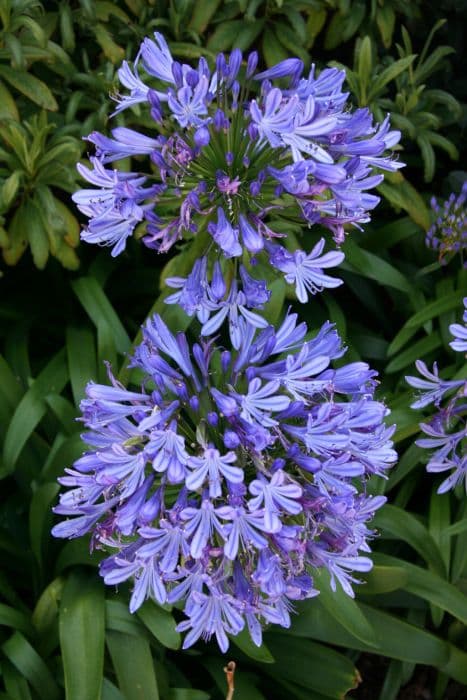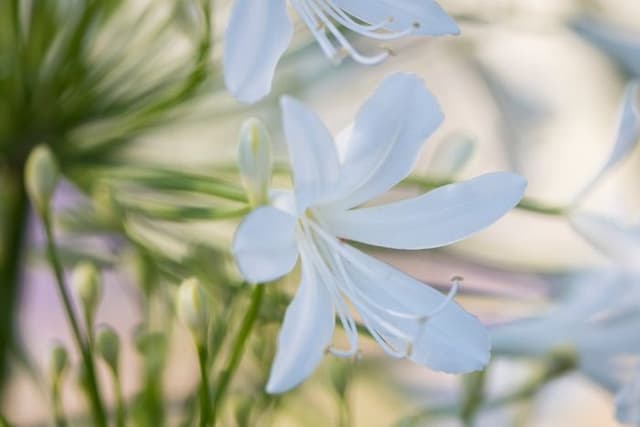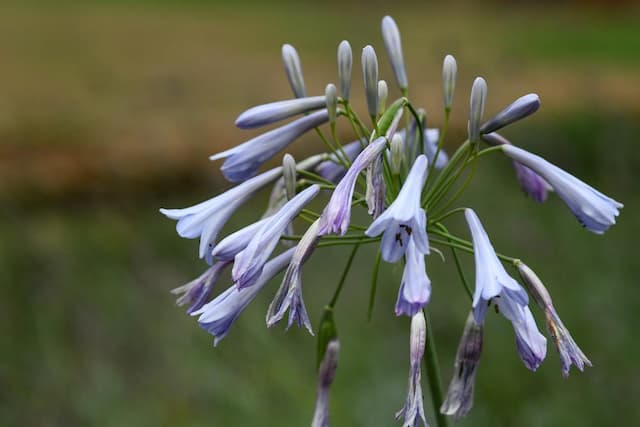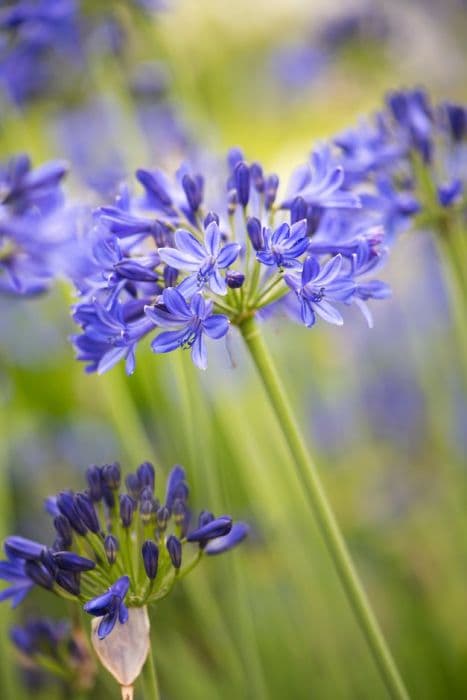Lily of the Nile Agapanthus 'Leanne'

ABOUT
Agapanthus 'Leanne' is a striking perennial with lush, strap-like green foliage that forms a dense clump, often giving it a graceful, fountain-like appearance. The leaves are glossy and arch gracefully towards the ground. This plant is renowned for its spectacular blooms which emerge on tall, sturdy stalks that rise above the foliage in the summer months. The flowers are arranged in large, rounded clusters, often referred to as umbels, which are composed of numerous trumpet-shaped flowers. These blossoms are a deep, vibrant blue, sometimes with a hint of purple, that draws the eye and adds a splash of color to any garden space. The individual flowers are delicate and slightly pendulous with a soft texture. Agapanthus 'Leanne' is commonly used in borders, as a focal point in garden beds, or planted in mass for a showy display.
About this plant
 Names
NamesFamily
Amaryllidaceae.
Synonyms
African Lily, Lily of the Nile.
Common names
Agapanthus 'Leanne'.
 Toxicity
ToxicityTo humans
The Agapanthus, commonly known as Lily of the Nile or African Lily, can be toxic when parts of the plant are ingested. The plant contains small amounts of toxic substances that can cause symptoms if ingested in significant quantities. These symptoms may include nausea, vomiting, abdominal pain, and diarrhea. In rare cases and with large ingestions, more severe symptoms such as difficulty swallowing, inflammation of the mouth and throat, or even respiratory issues might occur. It is generally advised to avoid eating any part of the Agapanthus plant to prevent these potential health consequences.
To pets
Lily of the Nile or African Lily is also toxic to pets, including dogs and cats. Similar to humans, ingestion of the plant can lead to gastrointestinal symptoms such as vomiting, diarrhea, and abdominal pain. In more severe cases, it can lead to drooling, lethargy, and breathing difficulties. If a pet ingests any part of the Agapanthus plant, it is recommended to seek veterinary care immediately as the plant can cause harmful effects, especially if consumed in large amounts.
 Characteristics
CharacteristicsLife cycle
Perennials
Foliage type
Evergreen
Color of leaves
Green
Flower color
Blue
Height
2 feet (0.61 meters)
Spread
2 feet (0.61 meters)
Plant type
Bulb
Hardiness zones
8
Native area
Southern Africa
Benefits
 General Benefits
General Benefits- Ornamental value: Agapanthus 'Leanne', often referred to as the African Lily, features striking blue flowers that make it an attractive addition to any garden or landscape.
- Drought tolerance: Once established, African Lilies are fairly drought resistant, making them suitable for water-wise gardens and reducing the need for frequent watering.
- Low maintenance: They require minimal care once established, making them a convenient choice for gardeners of any skill level.
- Long blooming season: Agapanthus 'Leanne' has a prolonged blooming period throughout the summer months, providing long-lasting color and interest.
- Pest resistance: These plants are generally resistant to pests, which helps to minimize the need for chemical treatments in the garden.
- Attracts pollinators: The flowers of the African Lily are known to attract bees and butterflies, which are beneficial for pollination and the overall health of a garden ecosystem.
- Border and container planting: Agapanthus 'Leanne' is versatile and can be used for borders or as a container plant for patios and balconies.
- Soil adaptability: They can tolerate a range of soil conditions, although they prefer well-draining soil which makes them adaptable to various garden situations.
 Medical Properties
Medical PropertiesThis plant is not used for medical purposes.
 Air-purifying Qualities
Air-purifying QualitiesThis plant is not specifically known for air purifying qualities.
 Other Uses
Other Uses- Photography Subject: The striking blue-purple flowers of Agapanthus 'Leanne' make it a popular subject for garden and macro photography, capturing the detailed structures of its blooms.
- Artistic Inspiration: Artists may use Agapanthus as a muse for paintings, drawings, and other forms of visual art due to its vibrant color and elegant shape.
- Eco-friendly Dye: The rich hues of the Agapanthus can be used to create natural dyes for coloring textiles, yarn, or paper.
- Garden Borders: Agapanthus can serve as a natural border in gardens, offering a colorful demarcation between different garden sections.
- Mood Enhancer: Due to its bright flowers, Agapanthus can be placed in living spaces to improve mood and create a more vibrant ambiance.
- Poolside Planting: They are often planted around pools where their tall flower stems can add a touch of elegance without dropping too many leaves into the water.
- Privacy Screen: When planted in a row or a cluster, Agapanthus can provide a semi-translucent privacy screen that is less imposing than a solid fence.
- Floral Arranging: Agapanthus flowers are long-lasting when cut, making them a favorite for floral arrangements and wedding bouquets.
- Theme Gardens: They can be used in a themed garden setting, such as a blue-and-white garden scheme, providing a consistent color palette.
- Stormwater Management: Agapanthus is effective at absorbing excess water in areas prone to heavy rain, reducing runoff and potential soil erosion.
Interesting Facts
 Feng Shui
Feng ShuiThe African Lily is not used in Feng Shui practice.
 Zodiac Sign Compitability
Zodiac Sign CompitabilityThe African Lily is not used in astrology practice.
 Plant Symbolism
Plant Symbolism- Love Letters: 'Agapanthus' is derived from the Greek words 'agape' meaning love, and 'anthos' meaning flower, together symbolizing love letters or a message of love.
- Beauty: The attractive blooms of the Lily of the Nile are often associated with beauty, which they add to gardens and landscapes where they are planted.
- Fertility and Pregnancy: In some cultures, the abundance of blossoms and the plant's growing habits symbolize fertility and the nurturing aspect of pregnancy.
- Endurance and Strength: The sturdy stems and persistent nature of the Lily of the Nile can symbolize enduring love or strength to overcome challenges.
 Water
WaterAgapanthus, commonly known as Lily of the Nile, prefers evenly moist soil, particularly during the spring and summer growing season. To achieve this, water the plant thoroughly until the water runs out of the drainage holes at the bottom of the pot, which might equate to about 1 gallon for a larger pot every week during the active growing season. In the winter, reduce watering to every other week, or when the soil feels dry to the touch a couple of inches deep, as the plant goes dormant and requires less moisture. Always avoid waterlogging as it may lead to root rot, so ensure the pot has good drainage.
 Light
LightLily of the Nile thrives best in full sunlight to partial shade conditions. It should be placed in a spot where it can receive at least six hours of sunlight daily. However, in regions with very hot summers, some afternoon shade can help protect the plant from intense, direct sunlight that could scorch the foliage.
 Temperature
TemperatureLily of the Nile grows best in temperatures between 50 and 80 degrees Fahrenheit. While it can survive minimum temperatures as low as 20 to 25 degrees Fahrenheit for short periods, prolonged exposure to freezing temperatures can be damaging. Ideally, maintain it in a location that avoids the extremes of cold or heat.
 Pruning
PruningPruning Lily of the Nile is mainly done to remove spent flower stalks and tidy up the plant. After the blooms have faded, cut the flower stalks back to the base to encourage new growth. Additionally, remove any yellowed or dead leaves to keep the plant healthy. The best time for pruning is late winter or early spring before the new growth begins.
 Cleaning
CleaningAs needed
 Soil
SoilThe best soil mix for Lily of the Nile (Agapanthus 'Leanne') is a well-draining, loamy soil enriched with compost or aged manure. A pH level of 6.0 to 7.0 is ideal for optimal growth and flowering. Adding perlite or coarse sand to the mix can improve drainage which is crucial for the health of Agapanthus.
 Repotting
RepottingLily of the Nile (Agapanthus 'Leanne') should be repotted every 2 to 4 years, or when it has become root-bound. It's best to do this task in spring before new growth begins to ensure the plant settles well in its new container.
 Humidity & Misting
Humidity & MistingThe Lily of the Nile (Agapanthus 'Leanne') tolerates a wide range of humidity levels but prefers moderate humidity. There is no specific humidity requirement, but avoiding extremely dry air is beneficial for the plant's health.
 Suitable locations
Suitable locationsIndoor
Place Lily of the Nile in a bright spot, no direct sunlight.
Outdoor
Plant in partial shade to full sun with good drainage.
Hardiness zone
8-10 USDA
 Life cycle
Life cycleAgapanthus 'Leanne', commonly known as Lily of the Nile, begins its life cycle as a dormant rhizome or seed. Upon germination or emergence from dormancy in the spring, it develops into a vegetative state characterized by strap-shaped leaves growing in a clump. As the plant matures, it develops tall flowering stalks, usually in mid to late summer, bearing clusters of trumpet-shaped, blue to purple flowers. After blooming, the flowers produce capsule-like seed pods that ripen and release seeds, starting a new generation if conditions are favorable. Throughout the growing season, the plant will expand through its rhizome, enlarging the clump. In the winter or during periods of cold, the foliage may die back, and the plant re-enters a period of dormancy, conserving its energy until the return of favorable growing conditions.
 Propogation
PropogationPropogation time
Spring to early summer
Agapanthus 'Leanne', commonly known as Lily of the Nile, is typically propagated by division, which is most successful when performed in the spring or early fall. This popular method involves gently separating the clumps of rhizomes that form at the base of the plant. Carefully dig around the clump, lifting it out of the soil while trying to keep as much of the root system intact as possible. Use a sharp, clean knife or spade to divide the clump into smaller sections, each with at least one growing point or shoot. Replant the divisions at the same depth they were growing previously, spacing them about 18 inches (or approximately 45 centimeters) apart to allow room for growth. After planting, water the new plants thoroughly to help establish their roots in the new location.









